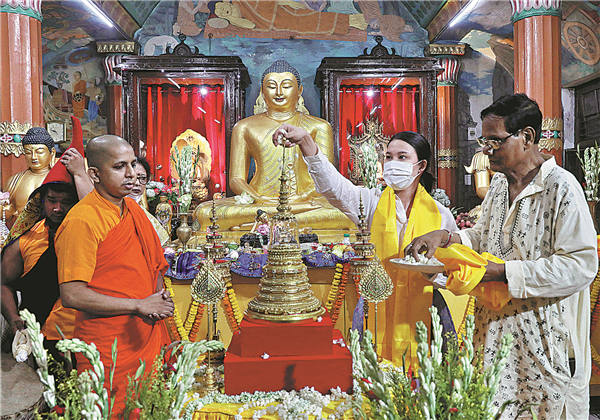

Center inaugurated
Last month, Bihar Chief Minister Nitish Kumar inaugurated the Mahabodhi Cultural Center in Bodh Gaya. The venue has an auditorium with a capacity of 2,000, two large conference halls, a dining hall that can seat 800, an art gallery and an audiovisual room that meets international standards.
Renu Devi, deputy chief minister of Bihar, said: "We are working to develop Bodh Gaya as one of 16 iconic destinations in India. We are also working to provide all types of facilities for Buddhist monks and tourists visiting the city."
Bodh Gaya is also home to many stunning Buddhist monasteries and pagodas run by foreign nationals and overseas organizations.
The Bodh Gaya Temple Management Committee closed the venue to visitors from March to September 2020 and again from April to August last year to prevent a surge in COVID-19 cases. A complete lockdown was imposed, with hotels and monasteries closing their doors to visitors as Bihar witnessed a surge in infections.
Harpreet Kaur, senior police superintendent, said the authorities in Bodh Gaya have now lifted all restrictions, and no cases of COVID-19 have been reported in the city since January. "We are keeping a close watch, and security arrangements were strengthened ahead of the Buddha Purnima festival," Kaur said.
According to a census in 2011, there were 8.5 million followers of Buddhism in India, while a census taken last year put the figure at about 10 million. The states of Maharashtra, Madhya Pradesh, Uttar Pradesh and West Bengal, along with those in the northeast of the country, have large Buddhist populations, according to the 2021 census.
Buddha Purnima, which is a public holiday in India, was celebrated this year in many places where COVID-19 restrictions had been lifted.
The festival was marked enthusiastically at popular pilgrimage sites in Uttar Pradesh and Bihar. Buddhists performed prayers, sermons and scripture recitals at these sites and also distributed food and clothing to the destitute. Widespread celebrations were also held in Buddhist areas such as Arunachal Pradesh and Ladakh.
For the festival, celebrants wear white clothing, meditate and only eat vegetarian food. The occasion is also often celebrated with the preparation of kheer, an Indian dessert that is offered to Buddha.
The celebrations in Bodh Gaya started with a procession from the city's 24-meter-high Buddha statue to the Bodhi Tree behind the temple. Hundreds of monks, devotees-including members of the International Buddhist Council-and the public took part in the procession.
The temple premises and adjoining area were adorned with colorful bunting, flowers and other decorative items. The festival was also celebrated in the evening with a procession from the temple.
"Special prayers and recitations of sacred scriptures for world peace were organized under the Bodhi Tree," a member of the Bodh Gaya Temple Management Committee said.
As in the previous two years, there were no Chinese tourists in Bodh Gaya, as direct flights between India and China have been halted due to the pandemic, the committee member said.
N. Dorjee, the committee's secretary, said that before the pandemic emerged, hundreds of monks and devotees from China, Sri Lanka, Thailand, Vietnam, Myanmar, Cambodia, Laos and Malaysia used to attend the festival every year.
This year, the festival was celebrated in several areas of New Delhi, the Indian capital. The city's Karuna Buddha Vihar temple began the day with prayers, later released birds and fish in the Yamuna river, and also organized cultural events to mark the event.
The writer is a freelance journalist for China Daily.